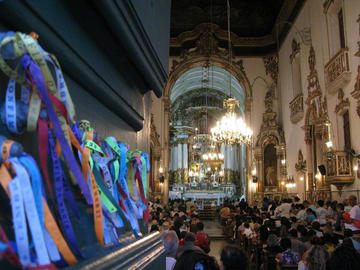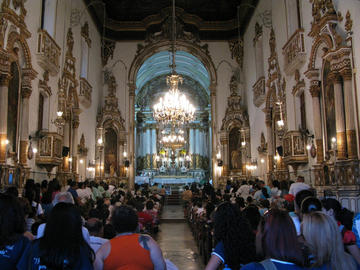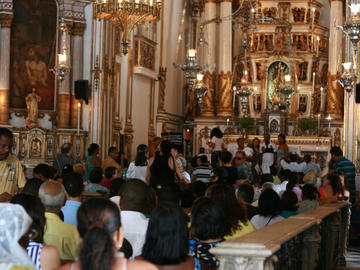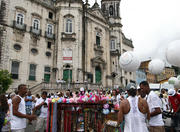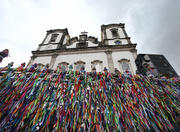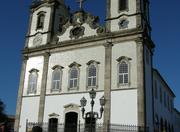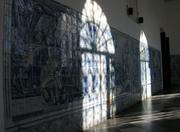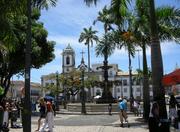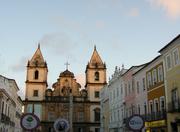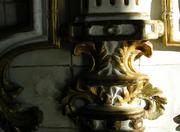Nosso Senhor do Bonfim Church Picture 2
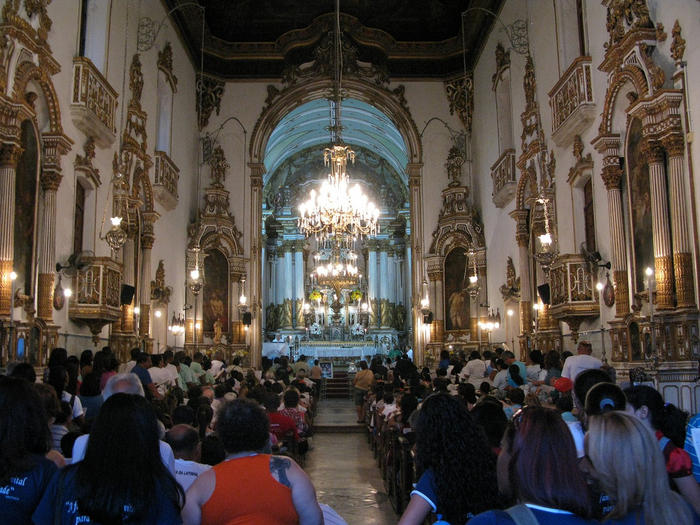
More information on Senhor do Bonfim Church in Salvador Bahia Photo by: Vitor D'Agnoluzzo
Senhor do Bonfim Church in Salvador Bahia
The church is named after the patron saint of Bahia is also a symbol of religious syncretism in Salvador. The tradition of washing the staircase and atrium with water began to smell with the slaves, in preparation for the feast in honor of the saint in January, and is maintained today by the Bahian Candomble. Another famous brand is the ribbon: Nobody leaves here without tying it on the wrist or at the gate.
The Church of Nosso Senhor do Bonfim is a Catholic church, is located in Holy Hill, on the peninsula of Itapagipe in Salvador, Brazil. Monument of Faith, Bahia for us, the Church of Bonfim is the largest center of the Catholic faith, and even those who, by syncretism, have in place the highest point of religion. Images of Our Lord of Bonfim and Our Lady came from Portugal's Guide to Bahia, through the Portuguese navy captain Theodozio Rodrigues de Faria, arriving on April 18, 1745, on Easter Sunday and being sheltered in the Church of Rock, built on the tip of the peninsula Itapagipana until 1754. This festival is considered the most important celebrations off in Salvador. With mobile data, the religious festivals (the feast of the sacred) is a novenário ending on the second Sunday after Epiphany. The festival is held in the Largo do Bonfim, right in front of the church, on top of Holy Hill, on the last Thursday before the end of novenário and is marked by the washing of the stairs and the churchyard on the Bahia dressed character, bringing water to the head of smell (much disputed among the faithful) to wash the floor of the church and flowers to decorate the altar. African-Catholic in worship, the Lord of Bonfim is syncretized with Hopefully, according to Verger, "no other apparent reason than to have him in this city, a huge reputation and inspire fervent devotion to the people of all social classes" (1997: 259). There is also a rapprochement between the Catholic party and the african-Brazilian cults, the "Waters of Hopefully." The party of washing is attributed to the promise of a devotee. It is believed that the ritual washing originated in the days when slaves were forced to carry water to wash the stairs of the basilica for the feast of white, since that time thanks to the graces of the people given by the Lord of Bonfim. It is considered the year 1804 as the official first wash. The procession in the morning still part of the Church of Nossa Senhora da Conceicao da Praia and goes to the Bonfim, drawing crowds for a distance of approximately 14 km. A presence on this path is the right of civil and military authorities, artists and personalities of the city of Salvador, Bahia and Brazil. Until the 50s the Bahian women had access to the interior of the church, where the floor was washed "with energy and enthusiasm" (Verger, 1990: 11), until the church authorities limited only to wash the churchyard. Parallel to religious festivals, there is still the party "profane", attended by typical food stalls and drinks from the top of Holy Hill. Since 1998 the party suffered a carnival party intervention imposed by the City and the Archdiocese of Salvador in an attempt to defend the historical traditions of the party, promoted a shift away from trucks and electric trios that followed the alternative blocks from the parade Avenida Contorno, sometimes even reaching the halfway point and a somewhat shifting and distorting the religious character of the day, promoting a mini-carnival entitled to all the excesses that are peculiar. On January 12, 2000 it opened a new illumination of the façade of the church. The project highlighted the lighting trusses and bell tower, pointing out the architectural elements and creating volumes. http://www.culturabaiana.com.br/igreja-de-nosso-senhor-do-bonfim-padroeiro-dos-baianos/More Photos of Nosso Senhor do Bonfim Church Picture 2
